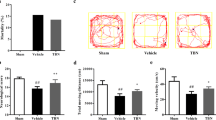Summary.
Background: Cerebral vasospasm is one of the important pathological phenomena which influence morbidity and mortality following subarachnoid haemorrhage. Reactive oxygen species (ROSs) generated by the autoxidation of oxyhemoglobin to methemoglobin may be one of the essential factors in the pathogenesis of cerebral vasospasm. The direct vasocontractile effects of hydrogen peroxide (H2O2), superoxide anion (O2 −), and hydroxyl radical (*OH) on the canine basilar artery and the inhibitory effects of MCI-186 (3-methyl-1-phenyl-2-pyrazolin-5-one), a new *OH scavenger, were investigated.
Method: Isometric tension was recorded in basilar artery rings from dogs in vitro. H2O2, pyrogallol (O2 − donor), and vitamin C (VitC)/Fe2+ (*OH-generating system) were used to generate the ROSs.
Findings: H2O2 (10 μmol/L), pyrogallol (10 μmol/L), and VitC/Fe2+ (100 μmol/L each) induced fast onset and transient, slow onset and transient, and sustained contraction, respectively, in the canine basilar artery. Contractions induced by H2O2 were almost completely inhibited by pre-incubation with catalase (800 U/mL) and those by pyrogallol with superoxide dismutase (150 U/mL), but neither with MCI-186 (10 μmol/L). The contraction induced by VitC/Fe2+ was clearly inhibited by pre-incubation with MCI-186, but not with catalase or superoxide dismutase.
Interpretation: ROSs have direct vasocontractile effects on the canine basilar artery in vitro, but different ROSs have different contractile characteristics. Such contractions might be related to the pathophysiology of cerebral vasospasm. MCI-186 had a clear and selective inhibitory effect against *OH-induced contraction in vitro. Comparison of different radical scavengers may be important in pharmacological assessment, especially targeted on cerebral vasospasm.
Similar content being viewed by others
Author information
Authors and Affiliations
Additional information
Published online December 5, 2002
Acknowledgments This study was partly supported by grants from the Ministry of Education, Science, Sports and Culture. We thank Ms. Umemura for technical assistance.
Correspondence: Masahiko Tosaka, M.D., Department of Neurosurgery, Gunma University School of Medicine, 3-39-22 Showa-machi, Maebashi, Gunma 371-8511, Japan.
Rights and permissions
About this article
Cite this article
Tosaka, M., Hashiba, Y., Saito, N. et al. Contractile Responses to Reactive Oxygen Species in the Canine Basilar Artery in Vitro: Selective Inhibitory Effect of MCI-186, a new Hydroxyl Radical Scavenger. Acta Neurochir (Wien) 144, 1305–1310 (2002). https://doi.org/10.1007/s00701-002-1020-8
Issue Date:
DOI: https://doi.org/10.1007/s00701-002-1020-8




